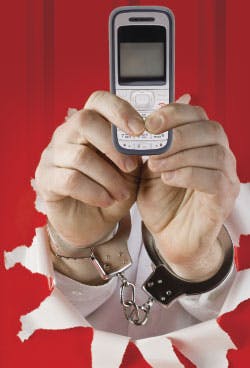In late 2008, a Texas governor received threats over the phone from an inmate on death row. In 2005, two South Carolina escapees were found with cell phones — it is understood the cell phones aided the attempt. Throughout the country convicts in prisons and jails alike manage to continue an active role in gangs and illegal activities.
Offering his unique insight, "Here we are using cell phones, the No. 1 communicating device, and yet no one has ever thought about protecting ourselves from it as well," says Howard Melamed, president and CEO of Florida-based CellAntenna Corp.
"It's an ongoing problem," says Congressman Kevin Brady (R-Texas). "More and more states are experiencing it." Texas has endured thousands of calls from inmates, some to prosecutors, victims and state law makers.
"Here in South Carolina," says Communication Director Josh Gelinas of the South Carolina Department of Corrections, "[prisoners] have used the phones to coordinate successful escapes on repeated occasions — from medium and maximum security institutions." He adds his department has seen inmates conduct credit card fraud or worse in the country.
This communication threat has risen to such a level that the cell phone contraband is commonly referred to as the "new cash" for inmates — in prison a pre-paid cell phone can run hundreds of percent over the retail price.
"From one inmate alone, our studies show that 50 inmates make use of one cell phone," adds Melamed. "This is the new cash. This is the new problem within prisons."
Anthony Diallo, public affairs specialist of the Washington, D.C., Department of Corrections agrees, "Perhaps the most dangerous contraband that can be found in any correctional facility here in Washington, D.C., or anywhere is the country is a cellular telephone."
Numerous correctional facilities have experienced the creative ways inmates sneak cell phones past guards and metal detectors. In South Carolina, Gelinas mentions inmates have found alternatives in transporting cell phones, whether through packaging or over a facility's fences. He explains that his department has recovered footballs carved open and stuffed with contraband such as cell phones, drugs, wire and fence cutters, etc.
As do all federal, state and local correctional facilities, South Carolina actively combats its contraband, but the existing cell phone presence creates its own paradox. Efforts are made to capture thrown-over contraband, yet inmates are able to precisely coordinate.
The combination of the cellular phone with convict entrepreneurship poses such a threat to public safety that many individuals — technological, correctional administration and governmental alike — have examined possible resolutions.
Current solutions include training K-9s to sniff out the cellular phone components, utilizing metal detectors, requiring all visitors and staff to relinquish belongings at security checkpoints, continued cell searches and utilizing cellular phone signal detectors to triangulate the outgoing signal.
South Carolina has been successful in stopping the flow of cell phones smuggled through its front doors by installing metal detectors and X-ray machines in all of its entrances, says Gelinas.
However, Melamed points out the unfavorable aspect of these solutions. "[They] involve the guards and correctional officers to be put into direct contact with the inmates — anyone in a prison facility or correctional institute would know you never want to do that."
George Camp, co-executive director of the Association of State Correctional Administrators, offers his insight as well. He sees efforts such as emptying the pockets of visitors and staff and scanning packages the necessary process used to prevent drugs and weapons from coming into prisons.
However, he also notices the cracks in the system. "We've found that [cell phones] can be secreted and hidden in ways that make them very difficult to detect."
"While there is equipment to locate the cell phone, it's not very accurate and at the same time it doesn't solve the entire problem," adds Melamed.
Even with front door metal detectors, the problem continues to persist; Gelinas feels that South Carolina has eliminated other alternatives to be successful in combating the issue. "We feel jamming is really the only effective method for our prison system and most likely others as well," he says. "We simply don't have the manpower to be everywhere at once. No prison system does."
However, amid much debate, jamming cellular signals within a prison is a violation of the Communications Act of 1934.
The Act (47 U.S.C. 301, 302a, 333) prohibits any person from willfully or maliciously interfering with the radio communications of any station licensed or authorized under the Act, or operated by the U.S. government.
Critics of this Act weigh on two opposite levels of a balance regarding the legitimacy of cellular signal jamming technology. One side states that, apart from the unlawful process of jamming, blocking the signal would prevent public emergency calls such as 911 and law enforcement radio communications. Until governmental action is taken, the jamming of the signal remains illegal.
However, such action remains to be a lucrative and attractive solution. Because illegal cell phone communications continue, Camp continues to voice concern for the safety of staff, the public, and law enforcement — while recognizing the need for citizens to be able to make 911 emergency calls from areas just outside prisons. "We are quite frankly baffled that there is not universal support for the use of this newly developed and tested cell phone jamming technology in prisons," he says.
He continues, "It's not just an issue for prison staff, where the consequences of cell phone usage are harmful, it also concerns us because the public can be put at great risk if these cell phones are used to plot an escape."
"The introduction of additional contraband is going to be made much more difficult because of what we already have implemented at the front door," agrees Gelinas. "Once we eliminate the use of cell phones, [inmates] won't be able to coordinate throw-overs or introduction of contraband as precisely as they can."
A demonstrationIn an attempt to see the technology in action, a few correctional facilities have scheduled a demonstration. At the time of this writing, South Carolina has been the only state to complete such an event — Texas and Washington, D.C., chose to cancel.
Today, months after the completed demonstration in South Carolina, interested parties are now examining the event's happenings. "In this example," explains Camp, "they were able to block transmissions within a building inside the prison, and yet you could step outside that same building and still use your cell phone."
Further demonstrations, though cancelled, were intended to show similar results. For an early January demonstration, the Federal Communication Commission offered a temporary permission to conduct the demonstration for the Washington, D.C., Department of Corrections. A letter to D.C. Corrections, written January 2, originally granted this "temporary authority" to conduct a 30-minute demonstration of the jamming equipment on January 8. In the letter the FCC acknowledges the interest to investigate the technology: "We agree that the proposed demonstration of equipment designed to prevent prisoners' unauthorized wireless telecommunications will benefit public safety. We find that the prosed demonstration will be narrowly tailored to limit impact on authorized wireless operations, while maximizing public safety benefits."
In response, the CTIA-The Wireless Association, an international nonprofit organization, petitioned the United States Court of Appeals for the District of Columbia Circuit to cancel the demonstration. In its petition, the CTIA claims that "Operation of such 'jamming technology' is flatly illegal under Section 333 of the Communication Act, and the commission lacks the statutory to authorize violations of this congressional directive protecting the rights of authorized users of the wireless spectrum. Moreover, the decision to authorize the demonstration — made without notice to the public or affected parties, without opportunity for comment, without consideration of any evidence regarding the potential consequences to legitimate transmission of operating the contemplated technology, and with no exigent public-safety need — is the very essence of arbitrary and capricious decision-making."
In a different request for demonstration approval, the FCC denied the Washington, D.C., Department of Corrections demonstration request. Written February 18, the letter states, "We find that the proposed jamming would violate both the Communications Act of 1934, as amended ... as well as the Commission's rules."
Congressional actionInitializing the required governmental action to combat the issue, a bill was introduced to Congress January 14. This bill, sponsored by Brady and Senator Kay Hutchinson (R-Texas) is titled "The Safe Prisons Act: To amend the Communications Act of 1934 to permit targeted interference with mobile radio services within prison facilities" (H.R. 560 or S.251). It hopes to create a common sense and narrow exception that allows state law enforcement to petition FCC for waiver to block those signals. Brady explains that the bill describes "jamming must only take place within the prison boundaries, and include specific instructions to the FCC to make sure that any jamming will not disrupt wireless signals outside the prisons." However, industry groups had not endorsed the bill, he notes.
Commenting on its inspiration, "State, law and prison officials ought to be able to block those cell phone signals without interfering with the general public or emergency use," he adds.
The bill includes stipulations on how the jamming technology could be delivered to correctional facilities. Brady explains that providers will be notified when a prison petitions for a waiver. Stipulations include that the jamming device can't interfere with public safety communications and does not penetrate outside the prison's wall. If either of these situations happens, the wireless provider then notifies the FCC and that prison must immediately stop its jamming — the FCC then investigates the interference.
The bill introduces a rule-making process, in which the commission will determine the types of technology that can be used. A secondary process will then allow the cell jamming companies to submit their devices for certification to identify usable devices. Once in place, individual correctional facilities can then submit waiver requests to operate the jamming technology.
Supportive of the legislation, "We believe that with the authority to implement and use that technology we can significantly use that technology to, if not completely, eliminate … cell phone transmissions within the prisons," says Camp.
"The corrections community — at the state, local and federal level — are united and are working closely with the Congress to move the legislation forward," he adds.
Putting the issue succinctly, the National Institute of Corrections seems to have the topic down to the issue's most simple argument: "Currently, it's illegal."

Jonathan Kozlowski
Jonathan Kozlowski was with Officer.com, Law Enforcement Technology, and Law Enforcement Product News from August 2006 to 2020.
As former Managing Editor for Officer Media Group, he brought a dedicated focus to the production of the print publications and management of the Officer.com online product and company directory. You can connect with Jonathan through LinkedIn.
Jonathan participated as a judge for the 2019 and 2020 FOLIO: Eddie & Ozzie Awards. In 2012, he received an APEX Award of Excellence in the Technology & Science Writing category for his article on unmanned aerial vehicles (UAVs) in police work, aptly titled "No Runway Needed".



